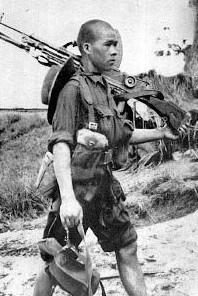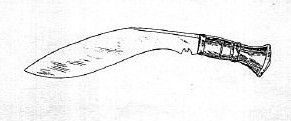|
|
|
.jpg)
“KAPHAR HUNNU BHANDA
MARNU RAMRO”
(It is better to die
than be a coward)

“Bravest of the brave,
most generous of the generous”
The Gurkha is a native of the Kingdom of Nepal, a small mountainous country between India and Tibet, and takes its name from the tribes which formed the army of King Prithwi Narayan, King of Gorkha.
The people of Nepal are divided into a number of races and tribes with clearly defined difference in features and characteristics. The Hinduism religion carries great value in their lives and daily activities.
The Gurkhas are the staunchest of friends to the British serving in the old Indian Army and later the British Army. In World War II the 3RD Battalion of the “Queen Elizabeth’s Own Gurkha Rifles” served in Burma under the command of General Orde Wingate with his “Chindits” and in 1944 the 1ST and 4TH Battalions went into Burma.
GURKHA REGIMENTS ALSO KNOWM TO HAVE SERVED IN BURMA DURING WWII
The 1ST King George
V’s Own Gurkha Rifles
(The Malaun Regiment)
The 2ND King Edward
VII’s Own Gurkhas
(The Sirmoor Rifles)
The 3rd Queen Alexandra’s Own Gurkha Rifles
The 4TH Prince of Wales’s Own Gurkha Rifles
The 5TH Royal Gurkha
Rifles
(Frontier Force)
The 7TH Duke of Edinburgh’s Own Gurkha Rifles
The 8TH Gurkha Rifles
The 9TH Gurkha Rifles
The foregoing list are the regiments known to the Twenty-Seventh Troop Carrier Squadron but is not to be considered a file of all the units that served in the China-Burma-India theater. The squadron flew many of these brave fighters into battle and supplied them from air as they advanced through the jungles.
~~~~<<<>>>~~~~

THE KUKRI
(The Gurkha’s National
Weapon)
The Kukri was the preferred weapon over of the Gurkha. The blade and hilt are curved. The blade is very thick at the back. From the back it is thinned off gradually to the edge which has a curve of its own, different to that of the back, so that the blade is widest as well as thicket in the middle and tapers at one end towards the hilt and at the other towards the point.
The point of the Kukri is as sharp as a needle thus the weapon answers equally for cutting and stabbing. The Gurkhas has a mode of striking which resembles the drawing cut of the broadsword, and which urges the sharp edge through flesh and bone.
The blade is so highly valued by the owner that it is never used for domestic purpose. For this purpose two smaller knives, of similar form, are used. They are kept attached to the side of kukri sheath.
The Gurkha generally strikes upwards with the kukri, possibly in order to avoid wounding himself should his blow fail, and possibly because an upward cut is just the one that can be least guarded against. When they come near the enemy they crouch close to the ground, dive under the bayonets, strike upward ripping the foe open with a single blow.
CREDITS:
Travels in India and
Nepal - 1896
The Gurkhas - date
unknown
~~~~<<<>>>~~~~
The knife was a prized
possession of several troopers of the Twenty-Seventh and was often carried
on missions should the aircraft go down in the jungles.
20 June 2001